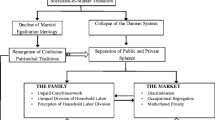Abstract
This article describes the various domains in which inequality manifests itself in Tanzania. It outlines the key drivers of inequalities as including wide income gaps, unemployment and a collusion between political and businesses elites that creates political capture and patronage, thus fuelling corruption and diverting resources from essential services. The article points out a correlation between access to education and income inequality, and highlights the fact that, despite marginal reduction in poverty, inequality is on the rise.

Similar content being viewed by others
Notes
Data sourced from http://www.indexmundi.com/facts/topics/poverty, which takes as its source the World Bank, Development Research Group. Data are based on primary household survey data obtained from government statistical agencies and World Bank country departments.
National Accounts of Tanzania Mainland: Publication 2001–2013 can be accessed through http://www.nbs.go.tz/, accessed on 18 February 2015.
Daily News (Thursday 30 May 2013) Hotuba ya Waziri wa Kazi na Ajira Mheshimiwa Gaudentia M Kabaka akiwasilisha bungeni makadirio ya mapato na matumizi ya fedha kwa mwaka 2013/2014, Para. 33.
Wageindicators.org and authors’ calculations. Exchange rates: www.oanda.com
The median wage is the middle of all observations within a defined category, for example, all female workers. It should not be confused with the average or mean wage, which is the sum of all wages of the individuals divided by the number of observations. The median has the advantage that it is not overly influenced by small numbers of high earners (www.wageindicator.org).
In Tanzania, the sample size was 175 health centres (135 rural and 40 urban) while the education sample size was 180 primary schools (132 rural and 48 urban). In Kenya, information was collected from about 303 primary schools (public and private) and 2,960 teachers.
This indicator measures teacher’s knowledge and is based on Mathematics and language tests covering the primary curriculum administered at the school level to all teachers currently teaching Maths and English in Grade 4, those who taught English and Maths at Grade 3 in the previous academic year, and up to 3 randomly selected upper primary Maths and English teachers. Source: http://documents.worldbank.org/curated/en/2013/07/18031388/education-health-services-kenya-data-results-accountability.
Between 2010 Tanzania has seen an increase of female parliamentarian from 63 to 93, permanents secretaries raised 30.2pc, and judges of the high court and court of appeal by 11 and 16pc, respectively (http://www.mcdgc.go.tz/).
BRN Annual Report 2013/2014.
References
Booth, David, Brian Cooksey, Frederick Golooba-Mutebi and Karuti Kanyinga (2014) East African Prospects: An update on the political economy of the Kenya, Rwanda, Tanzania and Uganda. London: Overseas Development Institute.
Cooksey, Brian and Tim Kelsall (2011) ‘The Political Economy of the Investment Climate in Tanzania’, Research Report 01, Africa Power and Politics Programme: London.
Edwards, David M. (1998) ‘Matetereka-The Last Ujamaa Village’, Occasional paper. Edinburgh: Centre for African Studies, Edinburgh University.
Hoffman, Barak (2013) Political Economy of Tanzania. Center for Democracy and Civil Society, Washington DC: Georgetown University.
National Bureau of Statistics (2012) ‘Employment and Earnings Survey – Analytical Report’, National Bureau of Statistics: United Republic of Tanzania, November.
Sumila, Veneranda (2013) ‘Warehouse Receipt System Increases Costs to Farmers’, The Citizen, 23 May.
Tanzania Commission for Human Rights and Good Governance (2012) ‘Report on Women in Leadership and Political Position in Tanzania’, Dar es Salaam: Tanzania Commission for Human Rights and Good Governance.
Therborn, Goran (2013) The Killing Fields of Inequality. Cambridge, MA: US Polity Press.
Therkildsen, Ole (2012) ‘Policy Making and Implementation in Agriculture: Tanzania’s push for irrigated rice’, DIIS/EPP Working Paper 2011:26. Danish Institute for International Studies: Copenhagen.
Tumusiime, Emmanuel and Edmund Matotay (2013) ‘Sustainable and Inclusive Investments Agriculture Investments: Lessons on the feed the future initiatives in Tanzania’, Oxfam America Research Backgrounder series, http://www.oxfamamerica.org/static/media/files/Tanzania_Sustainable_and_Inclusive_Investments.pdf.
WHO (2012) ‘Tanzania Country Profile’, World Health Organization – Noncommunicable Diseases (NCD) Country Profiles, http://www.who.int/nmh/countries/tza_en.pdf?ua=1.
World Bank (2013a) ‘Tanzania Lets Think Together’, June, www.blogs.worldbank.org/africacan/tanzania-lets-think-together.
World Bank (2013b) World Bank Service Delivery Indicators Education and Health Services in Tanzania. Washington DC: World Bank.
World Bank (2014) ‘Tanzania Economic Update: Who wants a job?’, https://openknowledge.worldbank.org/handle/10986/18943, accessed 15 October 2015.
Additional information
This case-study was prepared in the immediate follow-up of the Africa-wide Conference on ‘Inequalities in the context of Structural Transformation’, which was held in Accra, Ghana, on 28–30 April 2014. The paper was commissioned by the Organizing Committee of the Conference. For more information, please visit http://africainequalities.org/conference/
Explores inequalities in the context of structural transformation in Tanzania (country case study prepared in the follow-up of the Accra Conference on African Inequalities)
The Palma ratio is defined as the ratio of the richest 10 percent of the population’s share of gross national income to the poorest 40 percent’s share.
Rights and permissions
About this article
Cite this article
Matotay, E. Inequalities and Structural Transformation in Tanzania. Development 57, 591–600 (2014). https://doi.org/10.1057/dev.2015.46
Published:
Issue Date:
DOI: https://doi.org/10.1057/dev.2015.46




